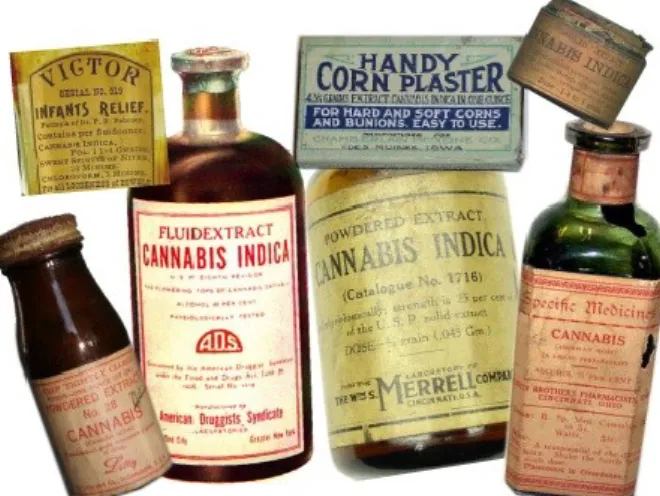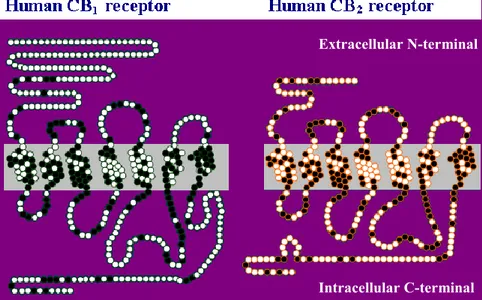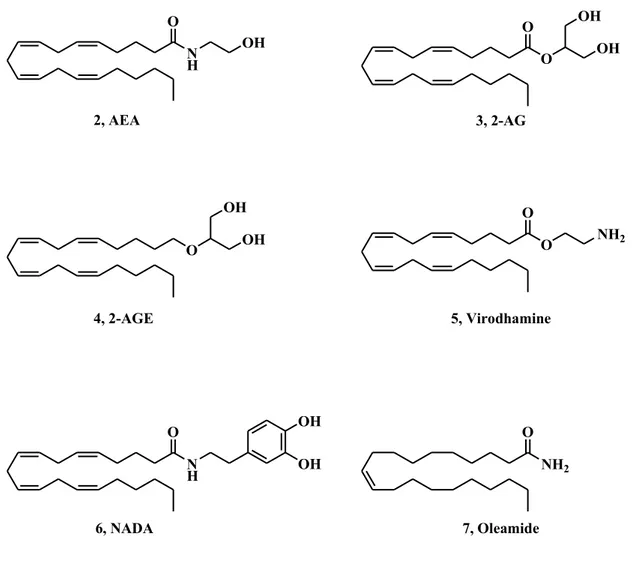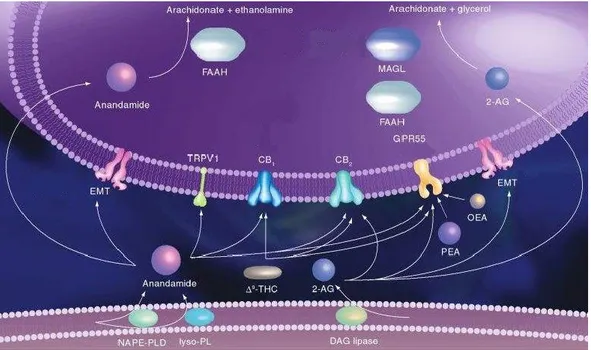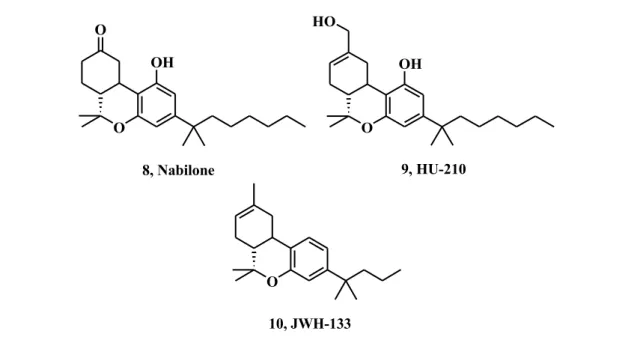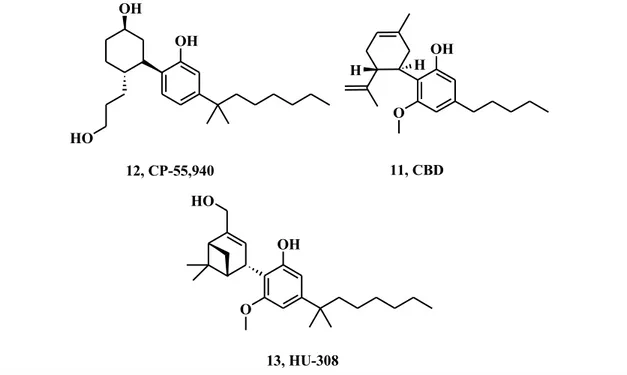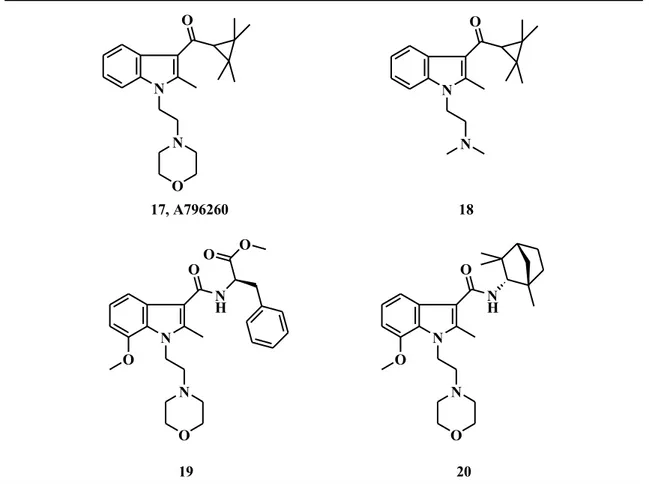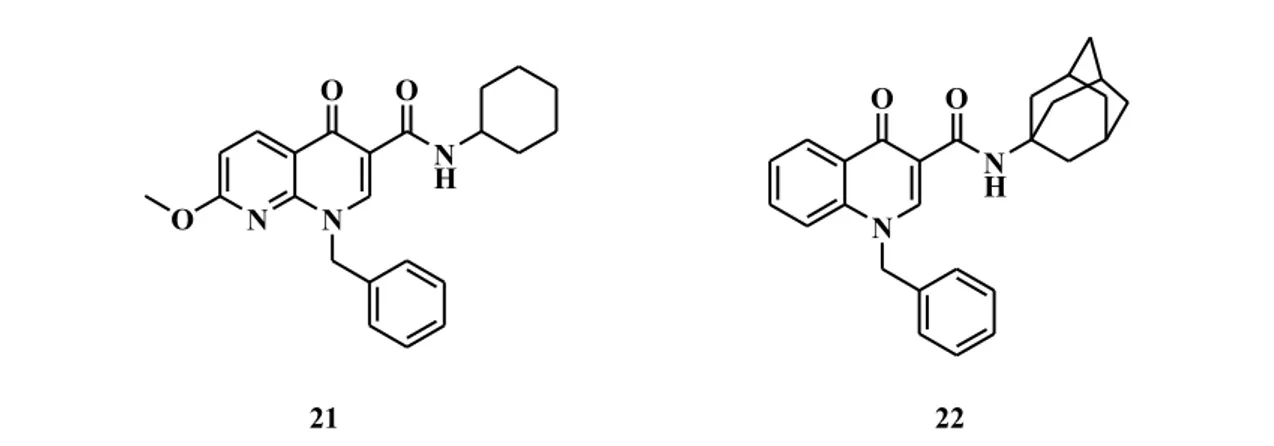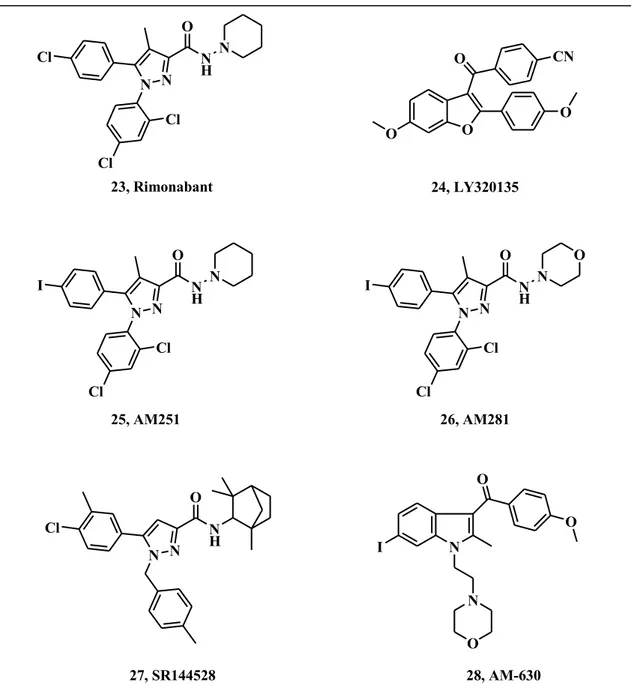Università degli Studi di Ferrara
DOTTORATO DI RICERCA IN
"SCIENZE FARMACEUTICHE"
CICLO XXVI
COORDINATORE Prof. Stefano Manfredini
Discovery of new CB
2cannabinoid receptor full agonists
Settore Scientifico Disciplinare
CHIM/08
Dottorando
Dott. Ruggiero Emanuela
Tutore
Prof. Baraldi Pier Giovanni
Co-tutore
Dott. Aghazadeh Tabrizi Mojgan
INDEX Appendix I Appendix II 1. Introduction 1.1 History 1.2 Cannabinoid Receptor 1.3 Endocannabinoid System 1.4 Cannabinoid Receptor Ligands
1.4.1 Agonists 1.4.2 Antagonists 1.4.3 FAAH Inhibitors 1.5 Therapeutic Targets
1.5.1 Nausea and vomiting
1.5.2 Neurodegeneration and neuroprotection 1.5.3 Appetite and obesity
1.5.4 Pain 1.5.5 Cancer
2. Research Purposes and Objectives 3. Development of diazepinoquinoline and
pyridoquinoxaline derivatives
4. Synthesis and biological evaluation of
oxazinoquinoline derivatives
5. Antinociceptive effects of the selective CB2
agonist MT178 6. Conclusions 7. Experimental Section 8. References I III 1 2 3 6 10 10 14 16 17 17 18 18 19 19 21 25 33 47 50 52 91
Appendixes
Appendixes
APPENDIX I Publications list
1. Pier Giovanni Baraldi, Giulia Saponaro, Allan R. Moorman, Romeo Romagnoli,
Delia Preti, Stefania Baraldi, Emanuela Ruggiero, Katia Varani, Martina Targa, Fabrizio Vincenzi, Pier Andrea Borea, and Mojgan Aghazadeh Tabrizi.
7-Oxo-[1,4]oxazino[2,3,4-ij]quinoline-6-carboxamides as Selective CB2 Cannabinoid
Receptor Ligands: Structural Investigations around a Novel Class of Full Agonists
J. Med. Chem. 2012, 55, 6608−6623.
2. Mojgan Aghazadeh Tabrizi, Pier Giovanni Baraldi, Giulia Saponaro, Allan
Moorman, Romeo Romagnoli, Delia Preti, Stefania Baraldi, Emanuela Ruggiero, Cristina Tintori, Tiziano Tuccinardi, Fabrizio Vincenzi, Pier Andrea Borea, and Katia Varani. Discovery of 7-Oxo-pyrazolo[1,5-a]pyrimidine-6-carboxamides as
Potent and Selective CB2 Cannabinoid Receptor Inverse Agonists. J. Med. Chem., 2013, 56 (11), 4482–4496.
3. Pier Giovanni Baraldi, Giulia Saponaro, Delia Preti, Stefania Baraldi, Emanuela
Ruggiero, Pier Andrea Borea, Mojgan Aghazadeh Tabrizi.
7-oxo-[1,4]oxazino[2,3,4-ij]quinoline-6-carboxamides as selective CB2 cannabinoid
receptor ligands: structural investigation around a novel class of full agonists.
Appendixes
Posters and oral presentations
1. Pier Giovanni Baraldi, Emanuela Ruggiero, and Mojgan Aghazadeh Tabrizi.
New Synthesis of Diazepino[3,2,1-ij]quinoline and
Pyrido[1,2,3-de]quinoxalines via Addition-elimination followed by Cycloacylation.. Berlin, Germany.
September 2-6, 2012
22nd International Symposium on Medicinal Chemistry
2. Pier Giovanni Baraldi, Giulia Saponaro, Delia Preti, Stefania Baraldi, Emanuela Ruggiero, Pier Andrea Borea, Mojgan Aghazadeh Tabrizi.
7-Oxo-[1,4]oxazino[2,3,4-ij]quinoline-6-carboxamides as Selective CB2 Cannabinoid
Receptor Ligands: Structural Investigation around a Novel Class of Full Agonists.
Ferrara 17-12-2012
XII Giornata della Chimica dell’Emilia Romagna
3. Emanuela Ruggiero, Mojgan Aghazadeh Tabrizi,Pier Giovanni Baraldi, Giulia Saponaro, Pier Andrea Borea. Design, synthesis and evaluation of new
pyrazolopyridine-5-carboxamide derivatives as CB2-receptor partial agonists.
Bologna 18-12-2013
Appendixes APPENDIX II Abbreviation list (5-HT)2 2-AG 2-AGE AD AEA AIMP ALS BSA cAMP CB CBD CDI CHO CNS COX-2 DAG DAGL DEEM DIPEA DMF DMSO eCB ECS EDC EMT FAAH FDA GABA GPCR HBTU 5-hydroxytryptamine 2-arachidonoyl glycerol 2-arachidonoylglyceryl ether Alzheimer’s disease anandamide
acid-induced muscle pain amyotrophic lateral sclerosis bovine serum albumin
cyclic adenosine monophosphate cannabinoid
cannabidiol
carbonyldiimidazole chinese hamster ovary central nervous system cyclooxygenase-2 diacylglycerol DAG lipase
diethyl ethoxymethylene malonate diisopropylethylamine dimethylformamide dimethyl sulfoxide endocannabinoid endocannabinoid system 1-ethyl-3-(3-dimethylaminopropyl)carbodiimide endocannabinoid membrane transporter
fatty acid amide hydrolase-1 Food and Drug Administration γ-aminobutyric acid
G protein-coupled receptor
o-benzotriazol-1-yl-N,N,N′,N′-tetramethyluronium
Appendixes HD HOBt MAGL MAPK MS NADA NA-lysoPE NAPE NAPE-PLD NBS ODA PA PD PI PLA2 PLC PPA PPAR SAR STZ TEA THC THF TLC TRP VIRODHAMINE Huntington’s disease 1-hydroxybenzotriazole monoacylglycerol lipase
mitogen-activated protein kinase multiple sclerosis N-arachidonoyldopamine N-arachidonyllisophosphatidylethanolamine N-arachidonoyl-phosphatidyl-ethanolamine N-acyl-phosphatidylethanolamine-selective phosphodiesterase N-bromosuccinimide cis-9,10-octadecanoamide Parkinson’s disease phosphatidic acid phosphoinositides type-A2 phospholipase phospholipase C polyphosphoric acid
peroxisome proliferator-activated receptor structure–activity relationship streptozotocin triethylamine tetrahydrocannabinol tetrahydrofuran thin-layer chromatography transient receptor potential
1. Introduction
1.1 HISTORY
Marijuana has been used for centuries as a recreational drug, because of its property to alter sensory perception and cause euphoria. Furthermore, its application as a medicine has been recorded for over five thousand years as for malaria, constipation, rheumatic pain and female disorders. Actually, some of the earliest hemp evidence have been traced in rope imprints on broken Chinese pottery, which date back to 10000 B.C. Chinese people used the hemp plant for their clothes, their writing materials, their “confrontation” with evil spirits, and in the treatment of pain and diseases. Consequently, they were the first recorded people to experience marijuana's peculiar psychotropic effects. Evidence of its use have been found also in India, where Cannabis were adopted for the treatment of numerous diseases, such as dysentery, loss of appetite, poor digestion. Around 500 B.C., marijuana spread in Northern Europe, basing on an urn containing cannabis leaves and seeds, unearthed near Berlin. Cannabis was introduced to modern western medicine by W.B. O'Shaughnessy, professor at the University of Calcutta. In 1839, after validating many of its applications, he documented its analgesic properties in the treatment of rheumatism, and as a remedy for severe convulsions. At the same time, a French psychologist J. J. Moreau de Tours suggested cannabis use to treat mental illness, so that the interest in medical cannabis spread from Europe to America and many formulations started to be prepared, such as analgesic pills and sedative tablets (Fig. 1).1
1. Introduction Beginning in the late 1960s, many academic studies have been carried out on marijuana, which demonstrated that cannabis effects, both psychotropic and therapeutic, are due to its hundreds natural components, which are classified on the basis of their chemical structure. The most psychoactive component of the hemp plant is tetrahydrocannabinol (THC), which is characterized by a terpenophenolic core, and is the parent compound of a major group, called cannabinoids.
Initially, the strong hydrophobic nature of this compounds suggested that marijuana elicited its effects by a non-specific perturbation of cell membranes rather than by a specific interaction with selective binding sites. The first important finding that ultimately led to a rejection of this theory was the identification by Gaoni and Mechoulam in 1964 of the chemical structure of the (-)-trans-Δ9-THC (1, Fig. 2).2 In particular, they established the exact geometry through X-ray crystallography and NMR analysis, which led them prove that, in THC-type cannabinoids, activity resides exclusively in the (-)isomers with the 6aR, 10aR stereochemistry. This represented the starting point for the development of a whole range of synthetic analogous in the 1970s, that were used as tools to investigate cannabinoid system.3
O OH
1, 9-THC 6a
10a
Fig. 2 Chemical structure of Δ9-THC
1.2 CANNABINOID RECEPTORS
Studies of the biological effects of THC and its synthetic derivatives revealed a drug-receptor interactions. Indeed, in 1990, Δ9-THC led to the identification of the first cannabinoid receptor, which was labelled as CB1. Three years later, in 1993, a second
cannabinoid receptor was identified, and consequently named CB2.4
CB1 and CB2 receptors are members of the superfamily of G protein-coupled receptors
1. Introduction (MAPK) by coupling with Gi/o proteins. They present structural omology of 44%, which
turns into 68%, considering just the transmembrane domains (Fig. 3).5
CB1 receptors are distributed abundantly and heterogeneously within the central nervous
system (CNS), where they mediate inhibition of the release of different excitatory and inhibitory neurotransmitters. A high density of CB1 receptors can be found in the
hippocampus, some olfactory regions, caudate, putamen, accumbens nucleus, substantia nigra, globus pallidus. Moreover, they are also present on some peripheral neurones as well as in certain nonneuronal tissues, like reproductive system. Given the distribution, their activation can affect processes such as cognition and memory, can alter the control of motor function, and induce signs of analgesia and hypothermia. However, it is worth mentioning that CB1 receptors are not widely express in the brain areas involved in
respiration and heart rate, reason why cannabinoid drugs are not lethal. Nevertheless, their activation is widely associated with psychotropic effects observed with non selective cannabinoids, thus limiting the therapeutic potential. CB1 receptor presents
unique properties: it has been preserved throughout evolution, considering that human, rat and mouse CB1 receptors have 97–99% amino acid sequence identity. This data
reflect the important functions played by endocannabinoids in cell and system physiology. Another remarkable characteristic of the CB1 receptors is their high
expression in the brain: actually, it is the most abundant GPCR in the brain, with densities about 50 fold above those of classical neurotransmitters.
Fig. 3 CB1/CB2 receptor homology
Extracellular N-terminal
1. Introduction Otherwise, CB2 was initially identified as a peripherally restricted receptor,
predominantly expressed in cells of the immune system, especially in monocytes, macrophages, B-cells and T-cells and, when activated, could modulate immune cell migration and cytokine release both outside and within the brain. However, subsequent data showed that it is also expressed in both the central and the peripheral nervous systems, especially in microglial cells. It is likely to be involved in inflammation-associated pathologies, such as human multiple sclerosis, osteoarthritis, rheumatoid arthritis, Crohn’s disease and inflammatory pain.3
Notwithstanding, further studies proved that many cannabinoid effects cannot be attributed exclusively to the CB1 and CB2 receptors activation. For example,
peripherally mediated antihyperalgesic activity persist in CB1- and CB2-gene knockout
animals.6 These findings have led to the suggestion of novel cannabinoid receptors. Actually, in 1999, an orphan GPCR was isolated and named GPR55, with low sequence identity with CB receptors (< 15%). It is expressed in the brain, in the vascular endothelium and in the immune system. And, it can bind a wide range of endogenous, natural and synthetic cannabinoid ligands. Yet, its mechanism of action remains uncertain.7 In addition, application of cannabinoids seems to generate a slow inward current in some of the transient receptor potential (TRP) channels, including TRPV and TRPA.8
1. Introduction
1.3 ENDOCANNABINOID SYSTEM
The characterization of cannabinoid receptors opened the way for the identification of the respective endogenous ligands, named endocannabinoids (eCBs), which chemical structures are depicted in Fig. 4.
N H OH O O O O OH O NH2 O NH2 O N H O OH OH OH OH OH 2, AEA 3, 2-AG 6, NADA 4, 2-AGE 5, Virodhamine 7, Oleamide
Fig. 4 Chemical structures of endocannabinoids
The first endogenous ligand for these receptors was isolated in 1992 and it was named anandamide (2, AEA). It showed the same physiological and pharmacological properties of natural and synthetic cannabinoids, such as analgesia, motor depression, catalepsy. Three years later, a second endogenous intermediate was found to interact with CB receptors, 2-arachidonoylglycerol (3, 2-AG). Following, other endogenous compounds that may also bind cannabinoid receptors have been discovered and each of them turned out to be an arachidonic acid derivative: 2-arachidonoylglyceryl ether (noladin ether, 4, 2-AGE), O-arachidonoylethanolamine (5, virodhamine),
N-1. Introduction Endogenous cannabinoids, along with CB receptors and the enzymatic pathways for the synthesis, transport and degradation of these ligands, constitute the endocannabinoid system (ECS).
Unlike classical neurotransmitters, eCBs are not stored in the cells but produced mainly
on demand by stimulus-dependent cleavage of membrane phospholipids precursors. In
particular, AEA is released from N-arachidonoyl-phosphatidyl-ethanolamine (NAPE), through an N-acyl-phosphatidylethanolamine-selective phosphodiesterase (NAPE-PLD). AEA acts as a retrograde messenger at presynaptic cannabinoid receptors (CB1),
where it regulates neurotransmitter release through its second transduction systems, mainly Ca2+. It is also involved in the neuromodulation of major transmitter systems, including dopamine, at postsynaptic cells, where it regulates synaptic plasticity through its modulation of potassium (K+) channels. It is also involved in the neuromodulation of major transmitter systems at postsynaptic cells, where it regulates synaptic plasticity through modulation of K+ channels and MAPK. Moreover, AEA is capable of interacting with other targets, such as the TRPV1 receptor and the peroxisome proliferator-activated receptors (PPARs).9 Recently, it has been suggested a different biosynthetic pathway, independent from NAPE-PLD, but involving a type-A2
phospholipase (PLA2), which hydrolyzes NAPE, releasing fatty acids and
N-arachidonyllisophosphatidylethanolamine (NA-lysoPE), an additional precusor of AEA. On the other hand, 2-AG is produced from the hydrolysis of diacylglycerols (DAGs) by DAG lipases (DAGLs) specific for sn-1 position. The molecules of DAG, which must possess an esteric function at sn-2 position, can be produced from the hydrolysis either of phosphoinositides (PI), catalyzed by a Ca2+-dependent phospholipase C (PLC), or of phosphatidic acid (PA) catalyzed by a specific Ca2+-dependent PA hydrolase.10
Subsequently, eCBs are transported in both directions through cell membrane by diffusion or selective transport by the putative endocannabinoid membrane transporter (EMT): a process that is fast rate, temperature-dependent, saturable, bidirectional and selective. In the extracellular space they can interact with cannabinoid receptors or be internalized and degraded. Endocannabinoid signalling is closed by a two-step process that includes transport into cells and hydrolysis by two specific enzymatic systems. AEA is metabolized by fatty acid amide hydrolase-1 (FAAH) in arachidonic acid and ethanolamine, while 2-AG is hydrolized by monoacylglycerol lipases (MAGLs) into arachidonic acid and glycerol. FAAH is a 64kDa integral membrane protein, which displays optimal activity at alkaline pH (about 9). It is composed by 597 amino acids and is rich in glycine and serine residues. Immunohistochemical studies confirmed that
1. Introduction the expression of this enzyme in different brain areas is directly correlated to CB1
receptor density.11 X-ray crystallography studies helped determine the enzyme structure and, consequently, led to the identification of binding sites. FAAH, unlike other amidases, does not use catalytic histidine-aspartate triad, but it presents a serine-serine-lysine sequence, in which Ser241 acts as a nucleophile, Ser217 stabilizes the negative charge and the Lys142 acts as a base.12 MAGL is a 33 kDa protein that belongs to the serine hydrolase family and presents a typical catalytic triad made of Ser122, His269 and Asp239. It is highly expressed in those areas of the brain rich in CB1
receptors.13
Moreover, recent experimental studies confirmed that AEA and 2-AG can function as substrate for cyclooxygenase-2 (COX-2) and some lipoxygenases. Actually, COX-2 efficiently oxygenates 2-AG and AEA into prostaglandin ethanolamides and prostaglandin glycerol esters respectively (Fig. 5).14
Fig. 5 Cannabinergic transmission15
AEA and 2-AG exhibit different binding properties and intrinsic activity at CB receptors. Actually, AEA behaves as a partial agonist at both receptors, with higher affinity for type-1 receptor. Alternatively, 2-AG is a full agonists at both receptor, but displays lower affinity than AEA.16
2-AGE is an ether-derivative of 2-AG, which binds mostly to CB1 and very weakly to
CB2 receptor. However, it has been demonstrated an opposite effect, because it can
1. Introduction AEA and 2-AG, which are rapidly hydrolyzed. Virodhamine acts as a partial agonist on CB1 receptors, even though it can be an antagonist of this receptor at higher
concentrations. It also acts as full agonist on CB2 receptor and can activate PPAR-α
receptor and GPR55. NADA is an endogenous ligand of CB1 and TRPV1 receptors. It
can act as either an endovanilloid or endocannabinoid, depending on which one it interacts with. Moreover, it is able to activate PPAR-γ. Finally, Oleamide acts as a full agonist of cannabinoid receptors with higher selectivity for the CB1 receptor.9
1. Introduction
1.4 CANNABINOID RECEPTOR LIGANDS
The ubiquitous distribution of the ECS correlates with its role as a modulator of multiple physiological processes. Synthetically produced compounds which display affinity to CB receptors may act either as agonists, enhancing the activity of eCBs, or as antagonists, preventing the binding of eCBs, and consequently inhibiting the activity of the ECS. Agonistic behaviour can be exploited for a wide set of applications: hypnotic, analgesic, antiemetic, antiasthmatic, antihypertensive, immunomodulatory, anti-inflammatory, neuroprotective and so on. On the other hand, cannabinoid receptor antagonism might be exploited in conditions with enhanced eCBs signalling, as drugs and alcohol addiction status.17, 18 Anyhow, it is possible to modulate ECS transmission and metabolism also by targeting the biosynthetic and hydrolytic enzymatic pathways (FAAH and MAGL inhibitors) or acting on the putative EMT.
1.4.1 Agonists
According to the International Union of Pharmacology3, cannabinoid receptor agonists can be classified in classical and non classical cannabinoids, aminoalkylindoles and eicosanoids (eCBs). Classical cannabinoids are defined by the characteristic tricyclic terpenophenolic moiety of the parent compound 1, 9-THC, and are also called phytocannabinoids. Compound 1 is a nonselective agonist that binds to both CB receptors, with a similar affinity of approximately 40 nM.19 It displays a wide range of therapeutically interesting effects, such as analgesia, anti-inflammatory, immunosuppressive, anticonvulsive, antiemetic, and orexigenic properties, albeit its employment has been restrained because of its psychotropic effects and drug abuse. The commercially available derivative of THC, known as Marinol®, is currently approved in the United States for treating nausea and vomiting in patients receiving chemotherapy. Its synthetic analogue Nabilone (8, Fig. 6), marketed as Cesamet®, was approved in 1985 by the Food and Drug Administration (FDA) for treatment of chemotherapy-induced nausea and vomiting and for chronic pain management. Cannabidiol (CBD, 11,
Fig. 7), on the other hand, lack the terpenophenolic core, and actually is a
non-psychotropic phytocannabinoid, that displayed strong antioxidant, neuroprotective, anti-ischemic and antiinflammatory effects. Interestingly, CBD displays very low affinity towards CB recpetors, whereon it acts as an antagonists. Surprisingly, emerging data from several studies has led to the recognition that CBD couples positively with the
1. Introduction putative new cannabinoid receptor GPR55 and, moreover, it can activate some ionotropic receptors, like TRPV and TRPA.8 Its commercially available formulation, Sativex®, is an oromucosal spray which delivers a 1:1 ratio of CBD and THC and it can be prescribed for neuropathic and oncological pain.
Starting from THC, different substitutions on the critical positions of the tricyclic scaffold (C-1, C-3, C-9) have been made, that led to the synthesis of numerous compounds. The most representative ones are described in Fig. 6.
O O OH 8, Nabilone O OH HO 9, HU-210 O 10, JWH-133
Fig. 6 Chemical structures of Classical cannabinoids
Synthetic cannabinoid HU-210 (9) displayed significantly enhanced affinity for both CB receptors, producing many of the same pharmacological effects as 1. Moreover, it has been demonstrated that the removal of C-1 hydroxyl group enhances the affinity for CB2 rceptor.18 Actually, in the des-hydroxyl series, compound 10, known as JWH-133,
showed 200 fold higher activity towards type-2 CB receptor, making it one of the most potent of the series.
Modifications of the terpenophenolic nucleus generated the so-called non classical cannabinoids.
1. Introduction 12, CP-55,940 OH OH HO OH 11, CBD O H H OH 13, HU-308 O HO
Fig. 7 Chemical structures of Nonclassical cannabinoids
This class of molecules include bicyclic or tricyclic analogues of THC that possess a replacement of the pyranyl ring or its entire loss. The most representative compound in this series (Fig. 7) is 12, CP-55,940, which behaves as a full agonist with high affinity for both CB1 and CB2 receptors. Its radiolabelled [3H] isotope is among the most widely
employed reference compound in the characterization of cannabinoid ligands. Compound 13, named HU-308, exhibited excellent selectivity for the CB2 receptor
(>440 fold) and showed anti-inflammatory and peripheral analgesic activity in a formalin-induced inflammation model in mice.20
In the early 1990s, it has been identified the first novel class of totally synthetic cannabinoid derivatives, charachterized by an aminoalkylindole core. These molecules present an indole scaffold substituted by a lipophilic aroyl group at C-3 and an aminoalkyl side chain at N-1 (Fig. 8).
O N N O O N O N I NO2 14, WIN55212-2 15, AM1241 N O 16, JWH-015 Fig. 8 Chemical structures of Aminoalkylindole derivatives
1. Introduction Compound 14, labelled as WIN55212-2, is one of the most studied synthetic cannabinoids in the series and has been widely utilized, as [3H] isotopic form, for pharmacological investigations in cannabinoid research.21 The aminoalkylindole series is probably the most studied among the synthetic cannabinoids. Actually, various compounds in this group are noteworthy, like 15, AM1241, which displays notable CB2
selectivity (SI > 80). Collectively, the indolic cannabinoids presented small substituents at C-2 of the indole core, because larger groups usually led to a loss in activity. Compound 16, JWH-015, also selective for the CB2 subtype, showed also
immunosuppressive properties.
Regarding C-3 position, although many of the synthetic cannabinoids have generally favoured 3-naphthoyl or 3-aroyl groups, a distinct chemical series carrying a tetramethyl cycloalkyl ketone has been developed, which displayed an interesting pharmacological profile. Compound 17 (A-796260) is a notable example, which revealed receptor affinity and selectivity about 192-fold over CB1 receptor. Subsequently, extensive SAR
studies have been carried out on the cycloalkyl ketone series, wherein side chain variations at the N-1 position led to potent and highly selective CB2 agonists (18, Fig. 9).22 N O 17, A796260 N O N O N 18 N N H O 19 N O O O O N N O O N H O 20
1. Introduction Afterwards, substitution of the ketone moiety with a bulky amide residue led to the formation of new indole-derived cannabinoid receptor ligands (19-20).23 Compound 19 displayed an excellent CB2 agonist behaviour, suggesting that a carboxamide residue
could be involved in receptor binding.
Actually, several independent groups reported CB2 selective 6,6-fused heterocyclic
modulators which maintained the amide function. A series of naphthyridines (21) and quinolines (22) were synthesized and analyzed for their cannabinoid activity (Fig. 10).24 Compound 22 provided the best pharmacological profile, with great affinity and 51-fold higher selectivity against CB1 receptor. These novel series demonstrated significant
analgesic effects in a mouse formalin test of acute peripheral and inflammatory pain.
N N O O N H O N O O N H 21 22
Fig. 10 Naphtyridine and Quinoline derivatives as CB2-receptor agonists
1.4.2 Antagonists
The developing of CB receptors antagonists aims to attenuate eCBs tone in those pathologies whose etiology involves high ECS activation. These medical conditions include eating disorders, especially obesity and associated cardiometabolic problems and drug addiction. To date, numerous CB antagonists have been synthesized, which are characterized by different chemical nucleus and are depicted in Fig. 11.
Specifically, the first CB1 receptor anatagonist 23, SR141716A, known as Rimonabant
(Acomplia®), presents a diarylpyrazole structure. It binds with significantly higher affinity to CB1 rather than CB2 receptors, and lacks significant affinity for
non-cannabinoid receptors. It behaves as an inverse agonist and showed clear clinical efficacy for the treatment of obesity and alcohol and tobacco addiction status.
LY320135 (24) presents a benzofuranic nucleus. It displays lower affinity to CB1,
compared to Rimonabant, but greater affinity to muscarinic, 5-hydroxytryptamine (5-HT) , histamine, dopamine receptors and adrenoreceptors, at different concentrations.
1. Introduction
AM251 (25) and AM281 (26) are both characterized by a dyarylpyrazole core, like Rimonabant. They showed respectively three and eight times less potency than Rimonabant and both compounds proved higher affinity for CB1 than CB2 receptors.25 Moving to CB2-receptor antagonists, they could have therapeutic potential in inflammatory disorders, arthritis and autoimmune diseases. However, their development is too limited to analyze their pharmacological profile. The most important known CB2
-receptor antagonists are the diarylpyrazole 27 (SR144528) and the aminoalkylindole 6-iodopravadoline 28, labelled as AM630. (Fig. 10). Compound 27 showed great selectivity towards CB2 receptor in both in vitro and in vivo assays, with a SI higher
than 700. Likewise, AM630 is a potent and selective compound which behaves as an inverse agonist for CB2, with a Ki of 32.1 nM, and displays a selectivity index over
165.26 O N H N N N Cl Cl Cl 23, Rimonabant O N H N O N N I Cl Cl O N H N N N I Cl Cl 25, AM251 26, AM281 O O O CN O 24, LY320135 N O N O I O 28, AM-630 O N H N N Cl 27, SR144528
1. Introduction
1.4.3 FAAH inhibitors
An attractive alternative to the preparation of CB receptors ligands is the development of FAAH inhibitors (Fig. 12), which raise the endogenous levels of eCBs by blocking their hydrolysis. This approach may avoid the undesired side effects of a conventional drug-receptor interaction.
To date, a remarkable series of potent, selective, and efficacious FAAH inhibitors have been disclosed and classified in reversible and irreversible compounds, basing on their mechanism of action. Many of them have been exploited as a tool to characterize the enzyme, define its mechanism of fatty acid amide hydrolysis, and validate it as a therapeutic target for the treatment of pain and inflammation.
The first class is characterized mostly by a -ketoheterocycle scaffold that binds to FAAH by reversible hemiketal formation with a serine residue of the active site. However, additional classes of reversible FAAH inhibitors have been reported later, including substituted (thio)hydantoins and imidazolidinediones, oxime, enol carbamates, benzothiazoles, benzoxazoles, arylboronic acids, selected sulfonamides, cyclic ureas and lactams. The most representative reversible FAAH inhibitor is compound 29, OL-135, which is reversible, competitive and selective. It produces analgesic, antinociceptive and anti-inflammatory activity in various preclinical animal models. However, much research groups focused on developing irreversible covalent FAAH inhibitors, in order to achieve long acting pharmacological activity in vivo. Carbamate-based inhibitors are the most studied class of irreversible inhibitors. Its lead compound is 30 (URB597), which binds to the active site and induces a carbamylation of Ser241, inactivating the enzyme. Analogously to reversible inhibitors, also the irreversible class has been increased with a lot of different compounds: actually, research in this field is still growing.27
O O N N 29, OL-135 O N H O H2N O 30, URB597 Fig. 12 Chemical structures of the most representative FAAH inhibitors
1. Introduction
1.5 THERAPEUTIC TARGETS
As introduced previously in this work,
Cannabis and its derivatives have always
showed great potential as therapeutic agents (Fig. 13). In the last decades, scientists primarily studied cannabis ability to alleviate various disease symptoms, such as the nausea associated with cancer chemotherapy. Today, research is directed towards the potential role of cannabinoids, investigating their property to moderate autoimmune disorders, such as multiple sclerosis (MS), rheumatoid arthritis, and inflammatory bowel disease, as well as their role in the treatment of neurological disorders, that is to say Alzheimer’s disease (AD) and amyotrophic lateral sclerosis (ALS). Moreover, many cannabinoids produce inhibition of pain responses and can be useful in management of glaucoma, bronchial asthma, inflammatory disorders and cancer.28
Some of the most widespread uses of cannabis derivatives are analyzed below.
1.5.1 Nausea and vomiting
The development of chemotherapy drugs has improved cancer treatment. However, this kind of compounds present remarkable side effects, such as nausea and vomiting, which may last for several days. These symptoms determine a reduction of patient compliance, interfering with therapy success. Since the discovery of the ECS, considerable researches confirm that cannabinoids serve as effective anti-emetics. In ferret and shrew models, the site of action has been identified in the emetic area of the brainstem and the dorsal vagal complex. It is has been confirmed that their anti-emetic properties are mediated by CB1 receptors; actually, CB1 antagonists SR-141716 and AM251
respectively potentiated the strength of toxin-induced vomiting in animal models. Yet, also CBD, which does not possess affinity for type-1 cannabinoid receptor, can produces anti-emetic effects. Consequently, further researches need to be carried on about this property.29
1. Introduction
1.5.2 Neurodegeneration and neuroprotection
Cannabinoids showed neuroprotective and anti-proliferative properties. Recently, many research groups have demonstrated the involvement of ECS in the protection against acute or chronic brain damage. In particular, phytocannabinoids, synthetic and endogenous cannabinoids showed neuroprotection both in vitro and in vivo cytotoxic models of ischemia and head trauma. In addition, cannabinoids are also neuroprotective in several chronic neurodegenerative diseases such as Parkinson’s disease (PD), Huntington’s disease (HD), ALS, AD and MS, which present excitotoxicity, mitochondrial dysfunction, inflammation and oxidative stress. There are few molecular mechanisms underlying these properties. Actually, they include some processes not mediated by CB receptors directly, but involving N-methyl-D-aspartate (NMDA) receptor antagonism, and others that are definitely mediated by either CB1 or CB2
receptors, which are able to reduce glutamate release, calcium influx and inflammation, while on the other hand, can stimulate γ-aminobutyric acid (GABA) activity.30
1.5.3 Appetite and obesity
Cannabis ability to stimulate appetite has been known all along its widespread. Recent experiments using synthetic or natural cannabinoid agonists have confirmed the role of the ECS as a modulator of food intake. However, the molecular mechanism is still far from being understood, and consequently its elucidation is the cornerstone of many researches. Based on these findings, dronabinol was approved by FDA in 1992 for the treatment of AIDS-related anorexia, a syndrome which occurs in about 18% of AIDS patients and which decreases the quality of life and the chance of recovery.
Interestingly, the first potent and selective CB1 cannabinoid antagonist, Rimonabant,
was able to reverse the hyperphagia induced by 9-THC and also determined changes in ingestive behaviours when administered alone. These results suggested to exploit cannabinoid antagonists for the treatment of eating disorders and, above all, obesity. Moreover, based on preliminary pharmacological studies, CB1 antagonists may also be
useful for the treatment of alcoholism, and in smoking cessation. Actually, clinical studies with Rimonabant have already shown increased tobacco-smoking abstinence as well as prevention of the secondary weight gain often associated with smoking cessation.
1. Introduction
1.5.5 Pain
Pain is a weakening condition that responds poorly to available therapies. It is generally associated with nerve injury, toxic insults and disease states. Consequently, drug discovery efforts have been directed toward the identification on novel analgesic targets. The role of cannabinoids in pain modulation has been systematically studied since the XIX century, although the mechanism underlying the analgesic effects was barely understood until the characterization of CB receptors. Actually, cannabinoids suppress allodynia and hyperalgesia in different neuropathic pain models, through CB1 and CB2
specific mechanism. These studies have not only provided a detailed understanding of the network of neural and inflammatory cells, but, moreover, have led to the comprehension of the physiological role of eCBs in pain regulatory circuits.
Nevertheless, the psychoactive effects mediated by central CB1-activation, represent an
important boundary in pharmacotherapies. It follows that novel approaches to minimize unwanted side effects, such as selectively targeting CB2-receptor, represent a valuable
direction for future evaluations.
1.5.6 Cancer
The therapeutic effects of cannabinoids on some cancer-related conditions, such as emesis, nausea, depression, muscle tension, insomnia, chronic pain and loss of appetite, have been widely investigated. The anti-neoplastic activity of 9-THC and its derivatives was first observed in the early 1970s, but no further investigations were performed on this topic until recently.
Several natural (THC and CBD), synthetic (WIN-55, 212-2 and HU-210) and endogenous cannabinoids (AEA and 2-AG) produce antiproliferative effects on a wide spectrum of tumour cells.31 More importantly, cannabinoid administration to nude mice delays the growth of various tumours, including lung carcinomas, gliomas, thyroid epitheliomas, skin carcinomas and lymphomas.
It has been proved that eCBs play a protective role in the early stages of tumour development. In a recent study, indeed, AEA and the corresponding biosynthetic precusors levels have been analyzed in various human tumours. In most cases, cancer tissues presented higher levels of AEA compared to the healthy tissues. As evidence, several tumour cell lines demonstrated the same peculiarities: the ability to synthesize eCBs, the expression of CB receptors and the expression of their biosynthetic enzymes,
1. Introduction confirming the involvement of ECS in the control of cell proliferation. Moreover, it has been demonstrated that AEA and 2-AG inhibit the cell proliferation in breast cancer and prostate cancer, through CB1 stimulation. Subsequent findings have than reported the
inhibitory action of cannabinoids on the growth of glioma cell lines, thyroid epitheliomas, and mast cell lymphomas. More recent studies have focused the attention on the effect of eCBs in angiogenesis and formation of metastases. In conclusion, the use of cannabinoid receptor ligands might not only slow down the growth of tumours via multiple mechanisms, but at the same time also attenuate the related disorders. However, many efforts still need to be done in this research area.32
2. Reseach Purposes and Objectives To date, CB2 receptor agonists have gained attention as potential therapeutic targets in
the management of numerous diseases. It is necessary to achieve selectivity towards this receptor subtype in order to avoid the characteristic central side effects, mediated by CB1-activation.
The purpose of this project has been the design, the synthesis and the biological evaluation of new CB2-selective agonists.
We designed a new chemical structure (Fig.14) that included the primary characteristics of the most active and selective CB2-receptor agonists (14, 22). Initially, we decided to
prepare a series of diazepinoquinoline (46-52) and pyridoquinoxaline (53-56) derivatives, basing on their easy preparation. Actually, we optimized the synthetic routes, obtaining the formation of the tricyclic scaffold in just three steps.33 Then, we synthesized different lipophilic carboxamide derivatives, in order to value the influence of carboxamide moiety on the receptor affinity.
The novel synthesized compounds have been evaluated in receptor binding assays, using [3H]CP,55-940 as radioligand. The preliminary obtained data were discouraging, giving affinity values higher than 150 nM.
Consequently, we needed to improve the molecular core, thus we designed a new hybrid chemical structure defined by a oxazinoquinoline scaffold (Fig. 15).
The first synthesized examples of this novel series (69-80) showed really promising results (Table 2) which led to explore the novel nucleus, by investigating the effect of different substitutions at the crucial positions (C-2, C-3, C-6, C-8, C-9, C-10) on the affinity for CB receptors.34
The novel oxazinoquinoline derivatives were tested in competition binding assays towards both rat and human CB receptors. Affinity values (Ki, nM) were used to
calculate the selectivity of these novel compounds versus CB2 receptors. The ligands
were also examined in cAMP assays on hCB2 (Chinese hamster ovary) CHO cells, in
order to evaluate the inhibition of the adenylyl cyclase activity and consequently the potency values (IC50, nM).
2. Reseach Purposes and Objectives 14 22 KiCB2 = 4,6 nM Ki CB2 =16.4 nM N O O N H N HN O N H O R1 O R2 N O N H O R1 HN O N O N H O R1 HN R 2 R3 R2 O N O N O 46 47-52 53-56
Fig. 14 Rational design of diazepinoquinoline and quinoxaline derivatives. Baraldi, P.G.; Ruggiero, E.; Agahazadeh Tabrizi, M. J. Het. Chem. 2014, 51, 101-105
2. Reseach Purposes and Objectives N O O N H 14 22 N O O O N H O N O N O N O N H O R1 HN R 2 R3 R2 70 47-52 KiCB2 = 4,6 nM Ki CB2 =16.4 nM Ki CB2 > 150 nM Ki CB2 = 2.52 nM
Fig. 15 Rational design of oxazinoquinoline compounds Baraldi, P.G.; et al. J. Med. Chem. 2012, 55, 6608-6623
Development of diazepinoquinoline
and pyridoquinoxaline derivatives
3. Development of diazepinoquinoline and pyridoquinoxaline derivatives
The 2,8-dioxo-1,2,3,4-tetrahydro-8H[1,4]diazepino[3,2,1-ij]quinoline-7-carboxamide
46 was prepared as described in Scheme 1. Starting o-phenylenediamine 31 was
condensed with acrylic acid to yield the benzodiazepin-2-one 32 in 68% yield.35 Following reaction with diethyl ethoxymethylene malonate (DEEM) at 140 °C led to the formation of the methylenemalonate derivative 33 in 90% yields. Cyclization of 33 in polyphosphoric acid (PPA) provided the tricyclic derivative 34 in 95% yields. After hydrolysis of the ethyl ester functionality of compound 34 in acidic conditions, the resulting carboxylic acid 35 was converted into the target carboxamide 46 under peptide coupling conditions. Scheme 1a NH2 NH2 N H H N O 31 32 N H N O EtOOC COOEt 33 i ii iii N HN O O O O 34 N HN O O N H O N HN O O OH O 35 46 iv v
a Reagents and conditions:
(i) acrylic acid, HCl conc., H2O, 70 °C, 3 h; (ii) DEEM, 140 °C, 2 h;
(iii) PPA, 140 °C, 1 h;
(iv) HCl 20%, CH3COOH, 100 °C, 4h;
(v)cyclohexylamine, DIEA, HBTU, DMF, rt, 16 h.
The synthesis of diazepinoquinoline derivatives 47-52 was initially realized as outlined in Scheme 2. 2,3-dihydro-1H-benzo[b][1,4]diazepines 36a-d were prepared by heating
o-phenylenediamine 31 with appropriate ketones in the presence of 2 mol%
N-bromosuccinimide (NBS) as a catalyst, which mechanism is depicted in Fig. 16.36 Subsequent addition-elimination reaction with DEEM did not afforded 38a-d as
3. Development of diazepinoquinoline and pyridoquinoxaline derivatives
expected, but determined hydrolysis of the iminic carbon nitrogen double bond, yielding diethyl 2-[(2-aminophenylamino) methylene]malonate 37.
Scheme 2 NH2 NH2 N H N N N EtOOC COOEt i R R1 R R1 R R X H N NH2 COOEt COOEt ii 31 36a-d 38a-d 37
a Reagents and conditions:
(i) appropriate ketone, 10mol % NBS, 40 °C, 4h; (ii) DEEM, 140 °C, 2 h.
The alternative route to prepare the tricyclic scaffold is shown in Scheme 3. Sodium borohydride (NaBH4) was used to reduce the carbon nitrogen double bond of
compounds 36a-d in 75-80% yield.37, 38 Saturation of prochiral imine 36c provided a
mixture of syn/anti diastereomers (3:1) that were separated by column chromatography on silica gel to furnish the syn-isomer 38c as major diastereomer. The syn-conformation was confirmed by NMR studies, such as NOEDIFF experiments, that showed the presence of NOE enhancements between H-3 ( = 2.39 ppm) and H-4 ( = 4.43 ppm) protons. Moreover, the saturation of H-4 ( = 4.43 ppm) protons did not reveal NOE with the cyclopentyl hydrogens.
Regarding compound 38d, surprisingly, hydrogenation with NaBH4 gave only the
syn-diastereomer. For compound 38d too, the configuration was assessed through NOEDIFF experiments. The saturation of C-2 methyl ( = 1.64 ppm) protons resulted in NOE enhancements at H-4 ( = 4.22 ppm), suggesting that the methyl at C-2 and H-4 should be oriented in the same direction. The 1H and 13C NMR data of this compound are completely consistent with those reported in literature for the sin-isomer.39
Condensation with DEEM at 140 °C for 2 h yielded the 5-methylenemalonate derivatives 39a-d (85-90%). The regioselective addition of DEEM at N-5 position was
3. Development of diazepinoquinoline and pyridoquinoxaline derivatives
preferred because of the less steric hindrance present at the 4-position rather than at the 2-position. Subsequently, cyclization reaction with PPA at 130°C in 30 minutes gave compounds 40a-d in 35-40% yields.40, 41 The chemical identity of ethyl carboxylate derivatives 40a-d has been established by 1H NMR and MS spectra, while NMR NOEDIFF studies were conducted in order to analyze the C-4 substituents. Actually, compounds 40a-d showed NOE enhancement from the position 6-CH to the 4-CH protons on the benzodiazepinoquinoline nucleus, confirming the addition of methylenmalonate chain on the NH close to the less steric hindrance carbon atom. Eventually, hydrolysis of the ethyl ester derivatives, followed by coupling with appropriate amines, gave the desired compounds 47-52.
Scheme 3a NH2 NH2 N H N i R R1R N H H N R R1R R2 ii iii 31 36a-d 38a-d R2 5 4 3 2 1 N HN O O O N H N R R1R R2 COOEt EtOOC R R1 R iv v 39a-d 40a-d R2 5 4 3 2 1 6 7 8 N HN O O N H N HN O O OH vi R2 R R1 R R R1 R 41a-d 47-52 R2 R2
a Reagents and conditions:
(i) appropriate ketone, 10mol % NBS, 40 °C, 4h; (ii) NaBH4, CH3OH, rt, 2h;
(iii) DEEM, 140 °C, 2 h. (iv) PPA, 140 °C, 1 h;
(v) HCl 20%, CH3COOH, 100 °C, 4h;
(vi) amine, DIEA, HBTU, DMF, rt, 16 h, or amine, EDC, HOBt, DMF, rt, 16h.
a: R = R1 = methyl, R2 = H b: R = R1 = ethyl, R2 = H
c: RR1 = cyclopentyl, R2R = cyclopentyl d: R =phenyl, R1 = methyl, R2 = H
3. Development of diazepinoquinoline and pyridoquinoxaline derivatives NH2 NH2 NHBr NH2 N NH2 H N NHBr N N Br OH R OH R Br OH R R R O R O H2O NH2 NH2 N N R R + H20 N N H R R N H N R R N H N R R NBS succinimide
Fig. 16 Mechanism for NBS catalyzed reaction. The amine of o-phenylenediamine is activated by NBS in
order to attack the carbonyl group of the ketone and providing intermediate diimine. Subsequently, a 1,3-shift of the hydrogen attached to the methyl group occurs to form an isomeric enamine, which cyclizes to afford the diazepine ring.
The synthesis of ethyl pyrido[1,2,3-de]quinoxaline-6-carboxamide derivatives is depicted in Scheme 4. Only few papers reported the preparation of 9-substituted-3,4-dihydroquinoxalin-2(1H)-ones and, generally, their synthesis has been developed starting from 2-nitrobenzenamine or 1-fluoro-2-nitrobenzeneas starting materials.42-44 We optimized a new synthetic approach from o-phenylenediamines, that reacted with 2-bromoacetate in presence of triethylamine (TEA) at 80°C to give the 3,4-dihydroquinoxalin-2-(1H)-ones (42a-d) in 80% yields.43 Preparation of target
compounds 53-56 proceeded analogously to the synthesis of previous tricycles, by addition of DEEM to 3,4-dihydroquinoxalin-2-(1H)-one derivatives 43a-d, followed by cycloacylation in PPA at high temperature to yield compounds 44a-d. Hydrolysis of ethyl 1,2,3,7-tetrahydro-2,7-dioxopyrido[1,2,3-de]quinoxaline-6-carboxylate 44a-d gave the correspondent carboxylic acids 45a-d in high yields. Finally, intermediates
45a-d were converted into the desired compounds 53-56, as shown previously.
The position of halogens 9-F, 9-Cl on the quinoxaline core in compounds 44b and 44c was confirmed by 1H NMR analysis. Moreover, 19F NMR resonance was used to resolve fluorine derivative 44b: it displays three signals at -114.070, -114.094, -114.119
3. Development of diazepinoquinoline and pyridoquinoxaline derivatives
ppm with scalar couplings of equal intensity (JHF (H-8) = JHF (H-9) = 10 Hz), which
confirm the presence of fluorine residue on C-9. Scheme 4a N H H N O R NH2 NH2 R 31a-d 42 a-d R1 R 1 43 a-d N H N O R EtOOC COOEt R1 i ii iii 44 a-d N R HN O O O O R1 N HN O N H O O N HN O OH O O R1 R R R1 45 a-d 53-56 v iv a, R = R1 = H b, R = F; R1 = H c, R = Cl; R1 = H d, R = R1 = CH3
a Reagents and conditions:
(i) ethyl 2-bromoacetate, TEA, DMF, 80 °C, 3h; (ii) DEEM, 140 °C, 2 h;
(iii) PPA, 140 °C, 1 h;
(iv) HCl 20%, CH3COOH, 100 °C, 4h;
3. Development of diazepinoquinoline and pyridoquinoxaline derivatives
Each of the newly synthesized compounds was examined in [3H]CP-55,940 competition binding experiments for their affinity and selectivity towards the rat and human recombinant CB1 and CB2 receptors (Table 1).
Initially, the choice of the three kind of scaffolds was due to their manageable preparation. Thus, we synthesized the new compounds 46-56, keeping the lipophilic carboxamide moiety, essential for the receptor binding.45
Unfortunately, among the three developed series, only 2,3,4,8-tetrahydro-8-oxo-1H-[1,4]diazepino[3,2,1-ij]quinoline-7-carboxamide derivatives (47-52) showed activity towards CB receptors, while compound 46, 53-56 resulted totally inactive.
In particular, introduction of an alkyl residue on the diazepine ring, such as methyl, ethyl, or cyclopentyl group, provided affinity for CB2 receptors, with a reasonable
selectivity. The best results in this series were obtained with compound 50, with hKi
CB2 = 153 nM and SI > 65. On the other hand, replacing the aliphatic moiety with an
aromatic residue, like the phenyl ring (48-49), gave a total loss of activity.
On the basis of these results, we hypothesized that the inactivity was due to the poor lipophilicity of these scaffolds (cLog P < 2.5). Actually, protein–ligand binding partially depends on lipophilic interactions, and the optimal cLog P for a class of ligands will depend on the nature of target protein. Since the endogenous ligands for the CB2 receptor are highly lipophilic fatty acid derivatives, a higher range of cLog P
values is required.46
Consequently, we decided to change the diazepine/piperazine cycle of the molecular core, designing a new hybrid chemical structure defined by a oxazinoquinoline scaffold (Fig.10).
Table 1. Affinity (Ki, nM) and Selectivity Index (SI) of the Novel CB Compounds 46-56 on Rat and
Human CB1 and CB2 Receptorsa
N HN O N H O O R3 R2 R1 53-56 N HN O O N H R3 R1 R2 R1 N HN O O N H R3 O 46 47-52 Ki (nM) Cpd R1 R2 R3 rat CB1b rat CB2c hCB1d hCB2e SI 14 (R)-(+)-WIN55,212–2 15.6 ± 1.4 7.58 ± 0.72 12.4 ± 1.3 4.53 ± 0.42 2.74 46 adamant-1-yl >10000 (1%) >10000 (1%) >10000 (1%) >10000 (1%) 47 CH3 CH3 adamant-1-yl 5250 ± 556 213 ± 22 4540 ± 425 165 ± 14 27 48 ethyl CH3 adamant-1-yl >10000 (1%) 194 ± 13 >10000 (1%) 153 ± 12 >65 49 ethyl H cyclohexyl >10000 (1%) 248 ± 16 >10000 (1%) 204 ± 15 >49 50 cyclopentyl cyclopentyl adamant-1-yl >10000 (1%) 3156 ± 282 >10000 (1%) 2852 ± 254 >3.5 51 phenyl H adamant-1-yl >10000 (1%) >10000 (15%) >10000 (1%) >10000 (21%) 52 phenyl H cyclohexyl >10000 (1%) >10000 (1%) >10000 (1%) >10000 (1%) 53 H H adamant-1-yl >10000 (1%) >10000 (1%) >10000 (7%) >10000 (1%) 54 F H adamant-1-yl >10000 (1%) >10000 (2%) >10000 (1%) >10000 (3%) 55 Cl H adamant-1-yl >10000 (1%) >10000 (1%) >10000 (1%) >10000 (1%) 56 CH3 CH3 adamant-1-yl >10000 (1%) >10000 (1%) >10000 (1%) >10000 (1%)
aThe data are expressed as the mean ± SEM of n = 4 independent experiments. bThe affinity values were calculated by using [3H]CP-55,940 as a radioligand on rat brain for CB1 receptors. cThe affinity values were calculated by using [3H]CP-55,940 as a radioligand on rat spleen for CB2 receptors.
dThe affinity values were calculated by using [3H]CP-55,940 as a radioligand on human CB
1 CHO membranes. eThe affinity values were calculated by using [3H]CP-55,940 as a radioligand on human CB
Synthesis and biological evaluation of
oxazinoquinoline derivatives
4. Synthesis and biological evaluation of oxazinoquinoline derivatives The desired 7-oxo-[1,4]oxazino[2,3,4-ij]quinoline-6-carboxamides 69-109 were developed following two synthetic strategies, based on the availability of the α-halo ketone or amino alcohol necessary to generate the desired substitutions on the oxazine nucleus. Racemic compounds 69-83 and 92-100 were prepared as outlined in Scheme 5. Deprotonation of 2-nitrophenols 57a-c, and subsequent alkylation with the appropriate α-halo ketones led to the formation of nitro ketones 58a-h. In the second step, reduction of the nitro function of 58a-h using 10% palladium-on-carbon in methanol (or methanol/THF (85:15) for 3-aryl derivatives) provided the benzoxazines 59a-g,i,j by a simultaneous reduction–reductive amination sequence. Apparently, compounds 59i and
59j were formed as a consequence of a ring-opening of the cyclopropyl precursors 58g
and 58h, respectively. Following reaction with DEEM at 140 °C gave the corresponding methylenemalonate derivatives 60a-g,i,j in 70–90% yields. Intermediates 60a-g,i,j were thermally cyclized in PPA for 1 h, providing the oxazinoquinoline ester derivatives
61a-g,i,j in high yields.47 Saponification of esters 61a–g,i,j with sodium hydroxide furnished the carboxylic acids 62a-g,i,j, which were converted into the target carboxamide derivatives 69-83 and 92-100, by an amidation reaction with the appropriate amines under peptide coupling conditions.
Alternatively, the synthesis of compounds 84-91, 101-104, 108-109 was realized by the procedure utilized for the preparation of optically active ofloxacine (Scheme 6).48 Ethyl 3-oxopropanoate derivatives (64a-c) were prepared starting from the corresponding benzoic acids (63a-c) by reaction with carbonyldiimidazole (CDI) in THF to give the imidazolide, and consequent condensation with the magnesium salt of monoethyl malonate under neutral conditions (90% yield).49 Afterwards, intermediates 64 a-c were converted in ethyl 2-(ethoxymethylene)propionate derivatives 65a-c by condensation with triethyl orthoformate in refluxing acetic anhydride. Compounds 65a-c were involved in an addition-elimination reaction with the proper amino alcohols in dry methylene chloride to yield the intermediates 66a–i. The oxazinoquinoline scaffold was obtained by cyclization using potassium carbonate (K2CO3) in dimethylformamide
(DMF) at 130 °C. After saponification of ethyl ester derivatives 67a-i, the resulting carboxylic acids were coupled with the appropriate amines as reported in Scheme 3, to afford the target carboxamide derivatves. In the same way, reaction of compounds 65a-c with the proper (R)- or (S)-amino alcohol gave the corresponding enantiomerically pure derivatives, detailed in Table 5.
4. Synthesis and biological evaluation of oxazinoquinoline derivatives Scheme 5a R2 R1 O NO2 R4 R5 O R2 R1 OH NO2 57 a: R1 = R2 = H, 57 b: R1 = CH3, R2 = H 57 c: R1 = H, R2 = CH3 O NH R1 R2 R4 R5 i ii
57a-c 58a-h 59a-h
O N R1 R2 R4 R5 O OEt O OEt iii N O R1 R2 O O O R4 R5 iv 60a-h 61a-h N O R1 R2 O OH O R4 R5 N O R1 R2 O N H O R7 R4 R5 v vi 62a-h 69-83 92-100 58-62 a: R1 = R2 = R4 = H, R5 = CH3 58-62 b: R1 = R2 = R4 = H, R5 = Phenyl 58-62 c: R1 = R2 = H, R4 = CH3, R5 = Phenyl 58-62 d: R1 = R2 = H, R4 = R5 = Phenyl 58-62 e: R1 = R4 = H, R2 = CH3, R5 = Phenyl 58-62 f: R1 = R2 = R4 = H, R5 = 4-Tolyl 58-62 g: R1 = R2 = R4 = H, R5 = Cyclopropyl 58 h: R1 = CH3, R2 = R4 = H, R5 = Cyclopropyl 59-62 i: R1 =R2 = R4 = H, R5 = Propyl 59-62 j: R1 = CH3, R2 = R4 = H, R5 = Propyl
a Reagents and conditions:
(i) -halo ketone, K2CO3, acetone (anhydrous), rt, 16 h;
(ii) H2 (4 atm), 10% Pd/C, MeOH, 4 h;
(iii) DEEM, 140 °C, 2 h; (iv) PPA, 140 °C, 1 h;
(v) 10% NaOH, CH3OH, 80 °C, 1 h;
4. Synthesis and biological evaluation of oxazinoquinoline derivatives Scheme 6a R2 F F R2 F F 63-65 a: R1 = R2 = H 63-65 b: R2 = H, R3 = F 63-65 c: R1 = R2 = F i ii OH O R3 R3 O OEt O R2 F F R3 O OEt O OEt
63a-c 64a-c 65a-c
iii N O R2 O O O iv R2 F F R3 O OEt O NH HO R5 R6 R3 R5 R6 66a-i 67a-i v vi N O R2 O OH O R3 R5 R6 N O R2 O N H O R7 R3 R5 R6 68a-i (R)-81, (S)-81 (R)-83, (S)-83 84-91 101-104 108-109 a: R2 = R3 = H, R5, R6 = H, Methyl b: R2 = R3 = H, R5, R6 = H, Ethyl c: R2 = R3 = H, R5, R6 = H, i-Propyl (R)-d: R2 = R3 = R6 = H, R5 = i-Butyl e: R2 = R3 = H, R5, R6 = H, Phenyl (R)-f: R2 = R3 = H, R5, R6 = H, Benzyl g: R2 = R3 = H, R5 = R6 = CH3 h: R2 = H, R3 = F, R5, R6 = H, Ethyl i: R2 = R3 = F, R5, R6 = H, Ethyl a Reagents and conditions:
(i) CDI, THF, (C2H5O)2Mg, monoethyl malonate, rt, 16 h; (ii) CH(OEt)3, Ac2O, 110 °C, 3 h;
(iii) appropriate (R)-, (S)-, or (R,S)-amino alcohol, CH2Cl2, rt, 1 h; (iv) K2CO3, DMF, 130 °C, 7 h;
(v) 10% NaOH, CH3OH, 80 °C, 1 h;
(vi) amine, EDC, HOBt, DMF, rt, 6 h or amine, DIEA, HBTU, DMF, rt, 16 h.
Finally, the target compounds 105-107 were synthesized by substitution of the fluorine atom at C-10 by treating the amide 103 with different nucleophilic agents (sodium methoxide, pyrrolidine, N-methylpiperazine) in alkaline conditions (Scheme 7). Moreover, the 4-methylpiperazine derivative 107 was transformed into the hydrochloride salt by treatment with 1,4-dioxane saturated with gaseous hydrogen chloride.
4. Synthesis and biological evaluation of oxazinoquinoline derivatives Scheme 7a N O O N H O F N O O N H O H3CO N O O N H O N N O O N H O N N i ii iii HCl
.
103 105 106 107aReagents and conditions: (i) CH3ONa, THF, 50 °C, 16 h;
(ii) K2CO3, DMF, pyrrolidine, 100 °C, 10 h;
4. Synthesis and biological evaluation of oxazinoquinoline derivatives The newly synthesized compounds were tested in [3H]CP-55,940 competition binding experiments in order to value their affinity and selectivity towards the rat and human recombinant CB1 and CB2 receptors (Tables 2-5).
Initially, it has been synthesized a series of 12 compounds (69–80, Table 2) bearing an aromatic moiety (phenyl or 4-tolyl) at C-3 of the oxazinoquinoline tricycle. Substituents on the carboxamide group at C-6 have been selected basing on known cannabinoid pharmacophores, such as those present in the naphthyridine24, 45, 50 (21) and quinolone
51-53 (22) derivatives.
As expected, the 3-phenyl analogues bearing a cyclohexyl (70), cycloheptyl (71), adamant-1-yl (72), or 3,5-dimethyladamant-1-yl (73) carboxamide showed great affinity at the CB2 and poor affinity at the CB1 receptors. Compounds 71 and 73 were the most
potent and selective in this group (71, h Ki = 0.81 nM, SI = 383; 73, hKi = 3.45 nM; SI =
133). Compound 69, possessing a cyclopentyl carboxamide moiety, showed lower affinity and poor selectivity at the CB receptors, suggesting that the carboxamide group plays an important role, as reported in literature.
Substitution of C-2 position with a methyl group resulted in a dramatic loss of affinity (74, hKi = 536 nM; 75, hKi = 332 nM), relative to that of the corresponding compounds
lacking the methyl group (compounds 70 and 72, respectively). Likewise, compound
76, which bears a phenyl group at C-2, was totally inactive at both CB receptors,
confirming that the affinity of this class requires the C-2 position of the oxazinoquinoline nucleus unsubstituted. Intriguingly, the introduction of a methyl group at the para-position of the phenyl ring at C-3 (77, 78) provided a remarkable loss of affinity and selectivity for both CB receptors, in comparison with those of the analogous compounds 70 and 72 lacking this substituent. These data suggest that an excessive steric hindrance at this position prevents the receptor binding.
It has been also investigated the substitution of C-9 of oxazinoquinoline scaffold, however the presence of a methyl group resulted in lower affinity (79, hKi =18.4 nM)
and selectivity values, compared to those of the analogue without the methyl group (70). Derivative 80 was not tested due to its low solubility in DMSO/water.
